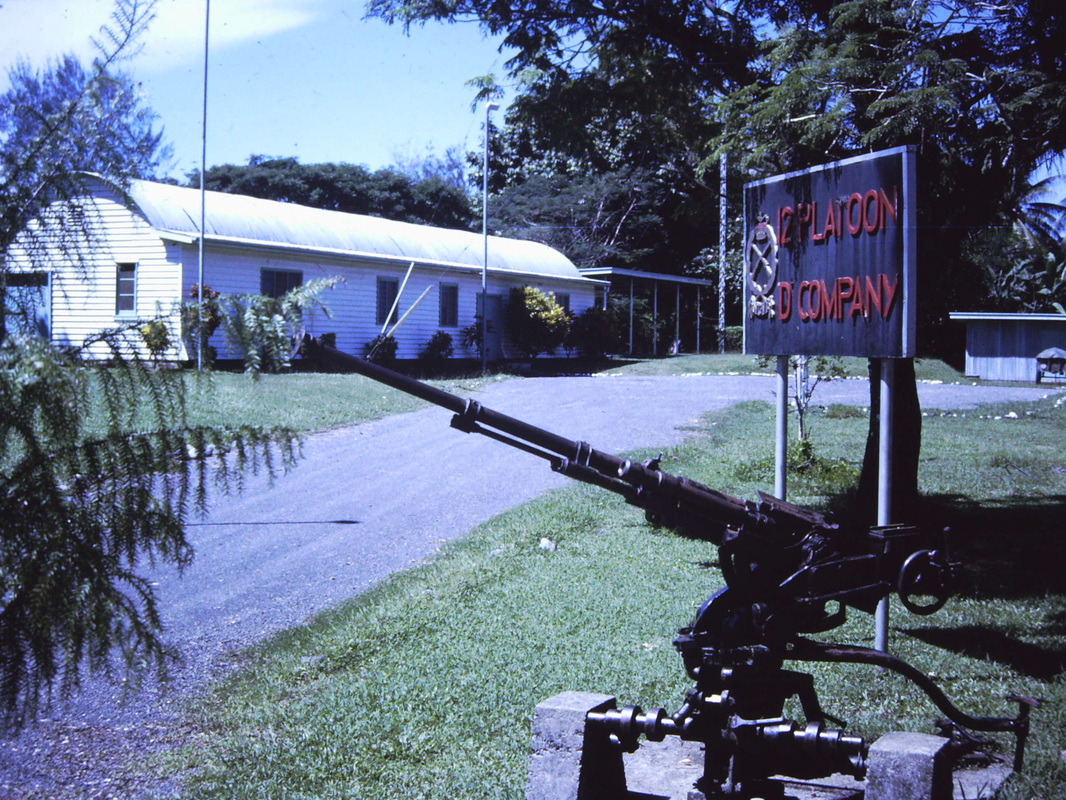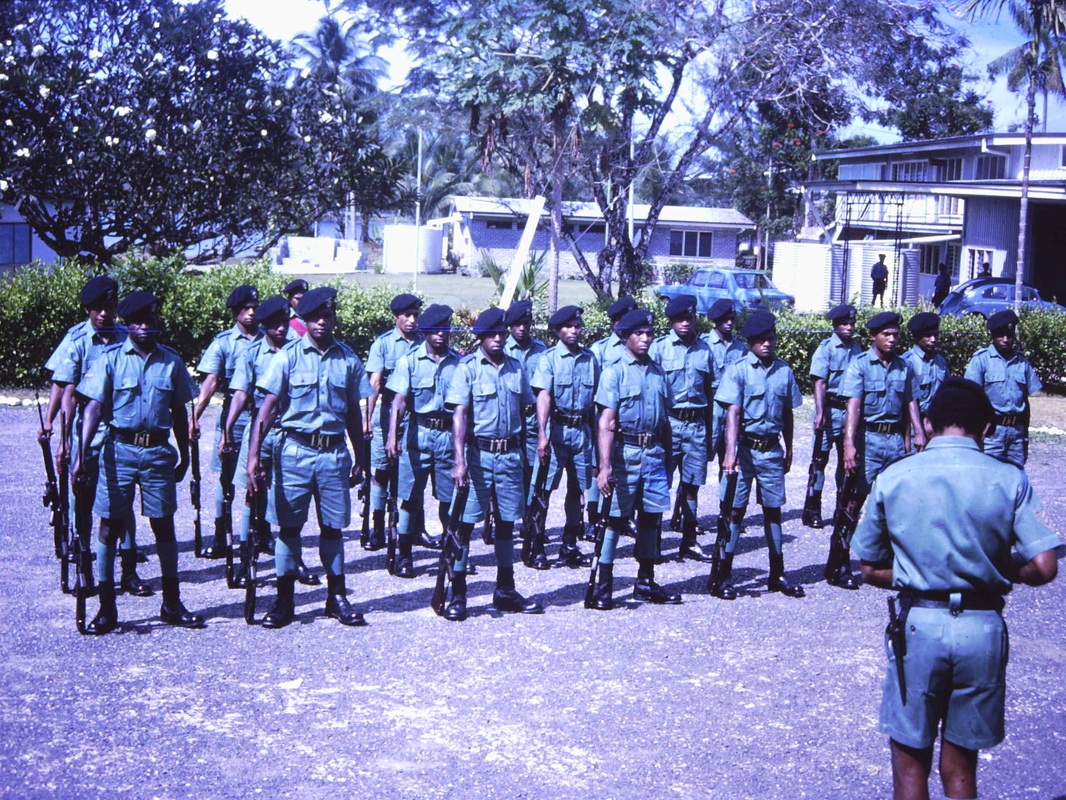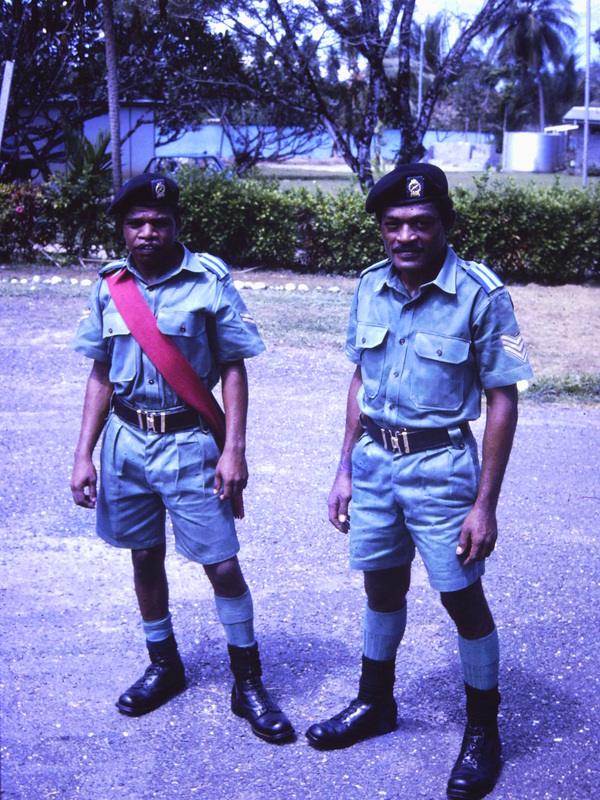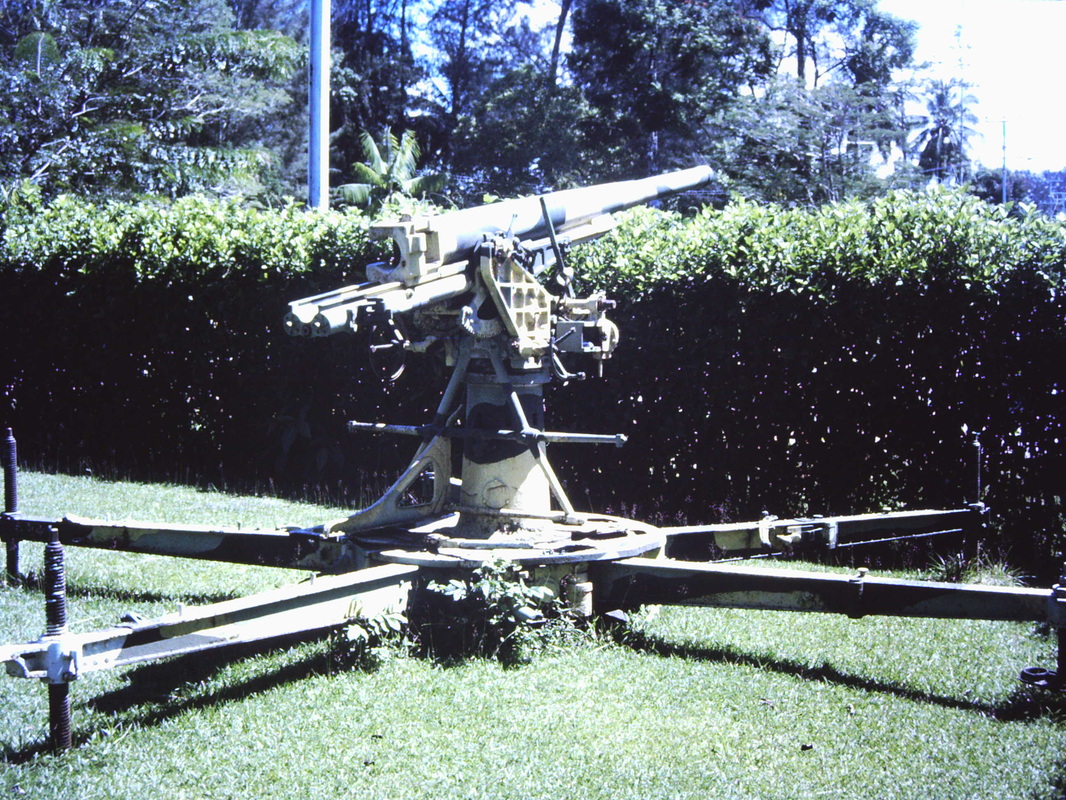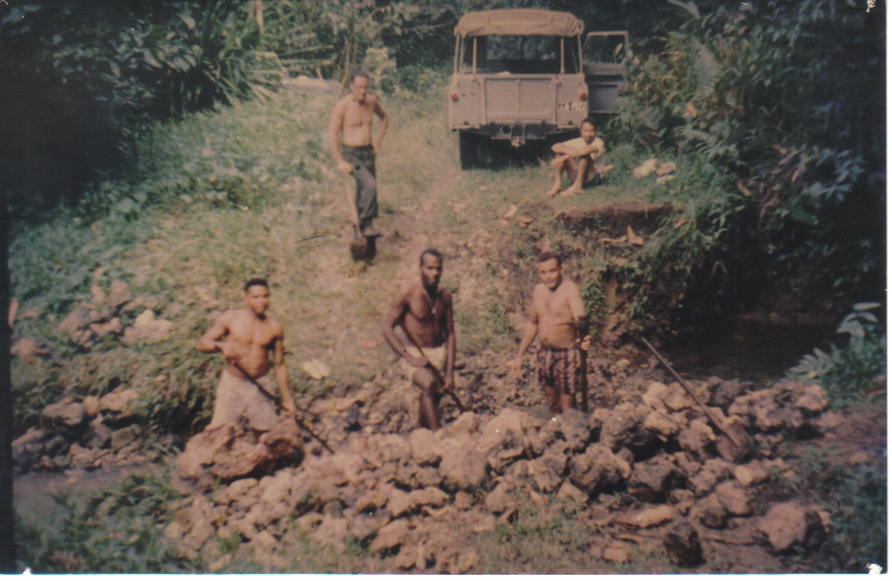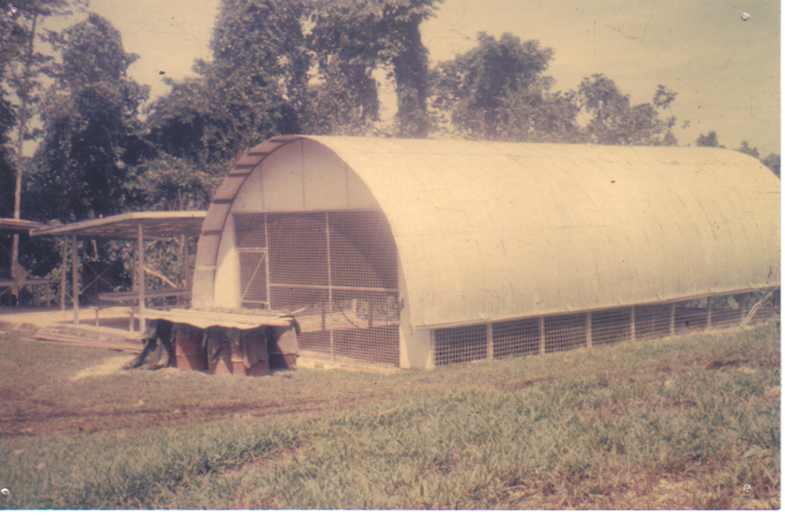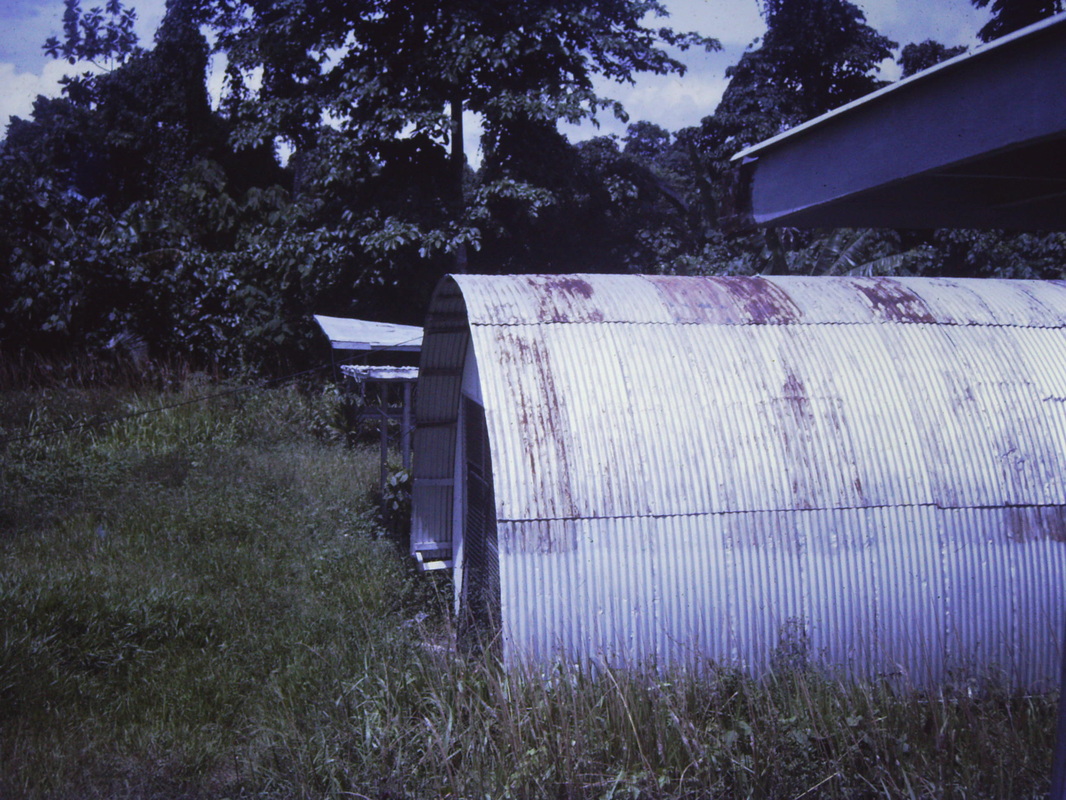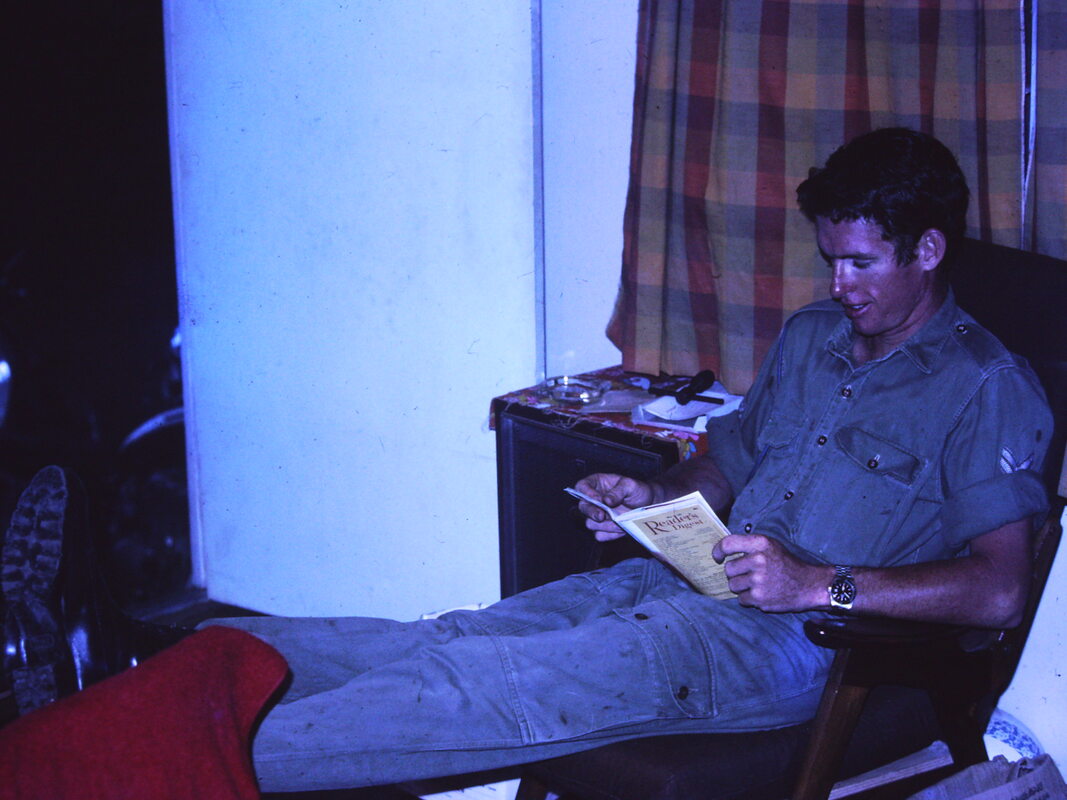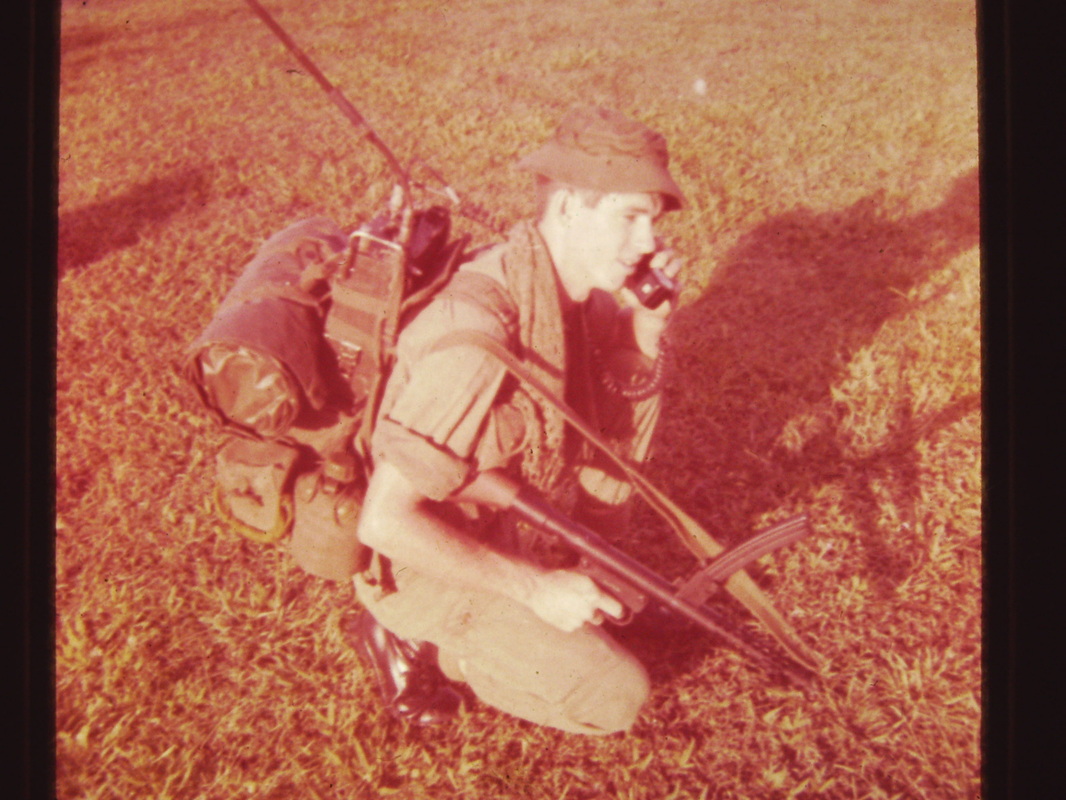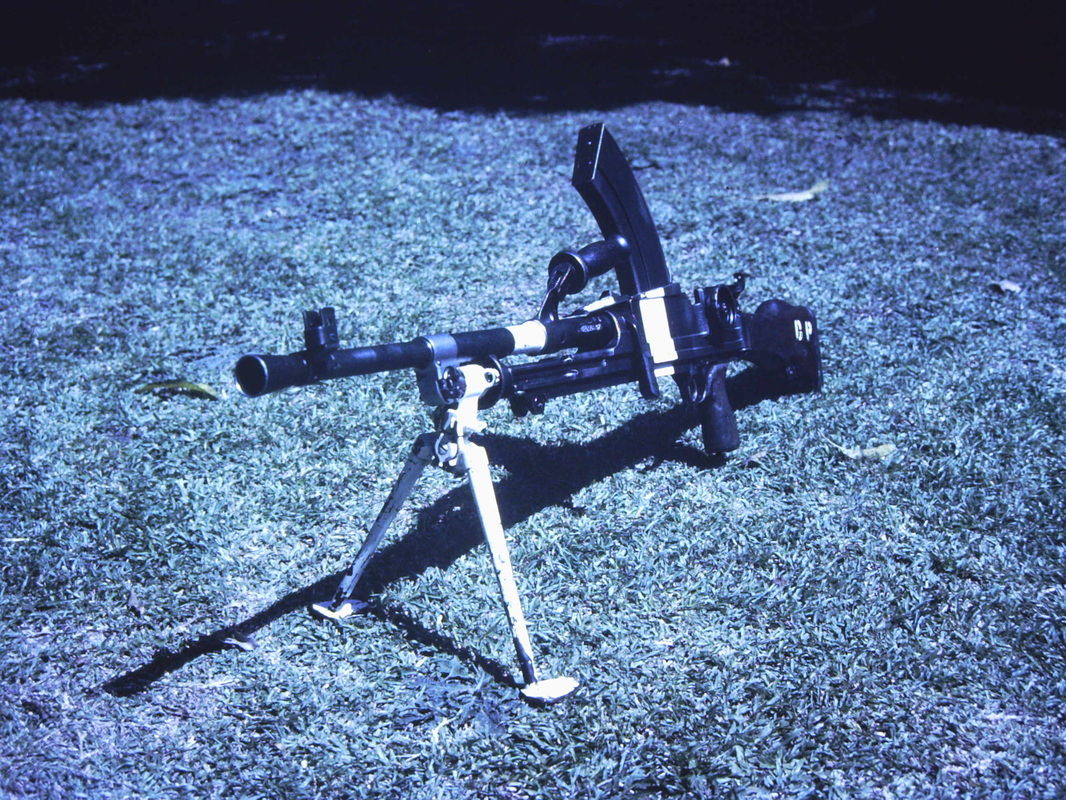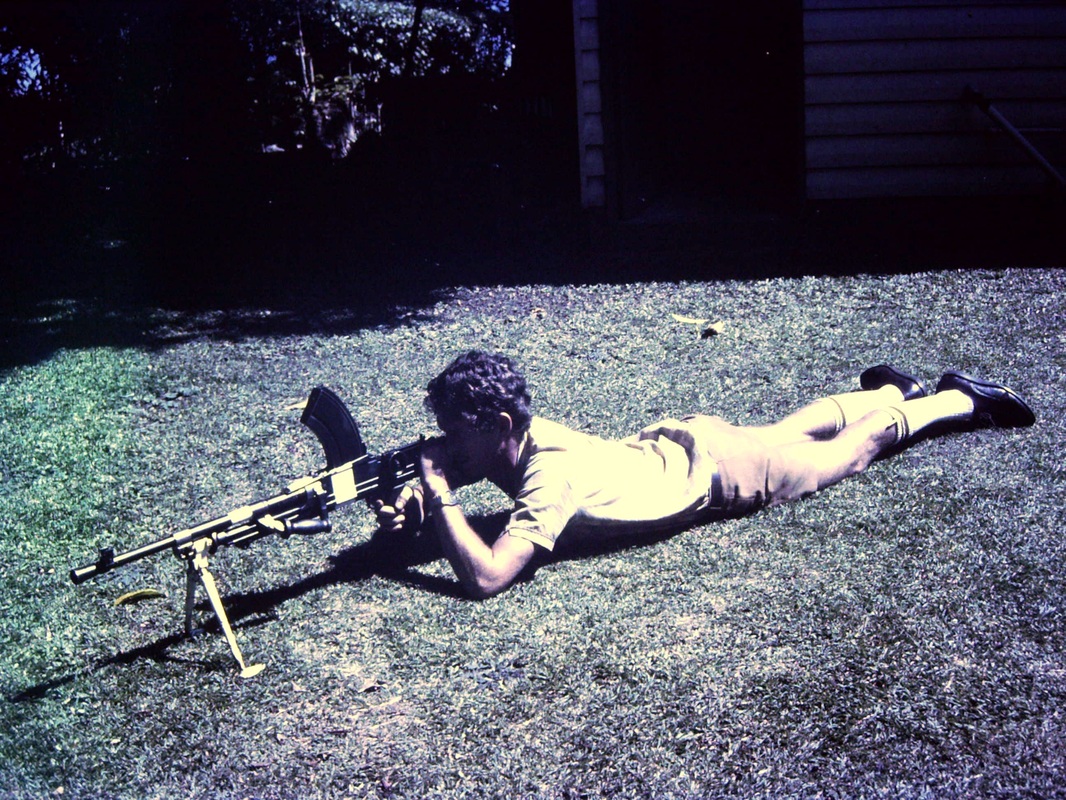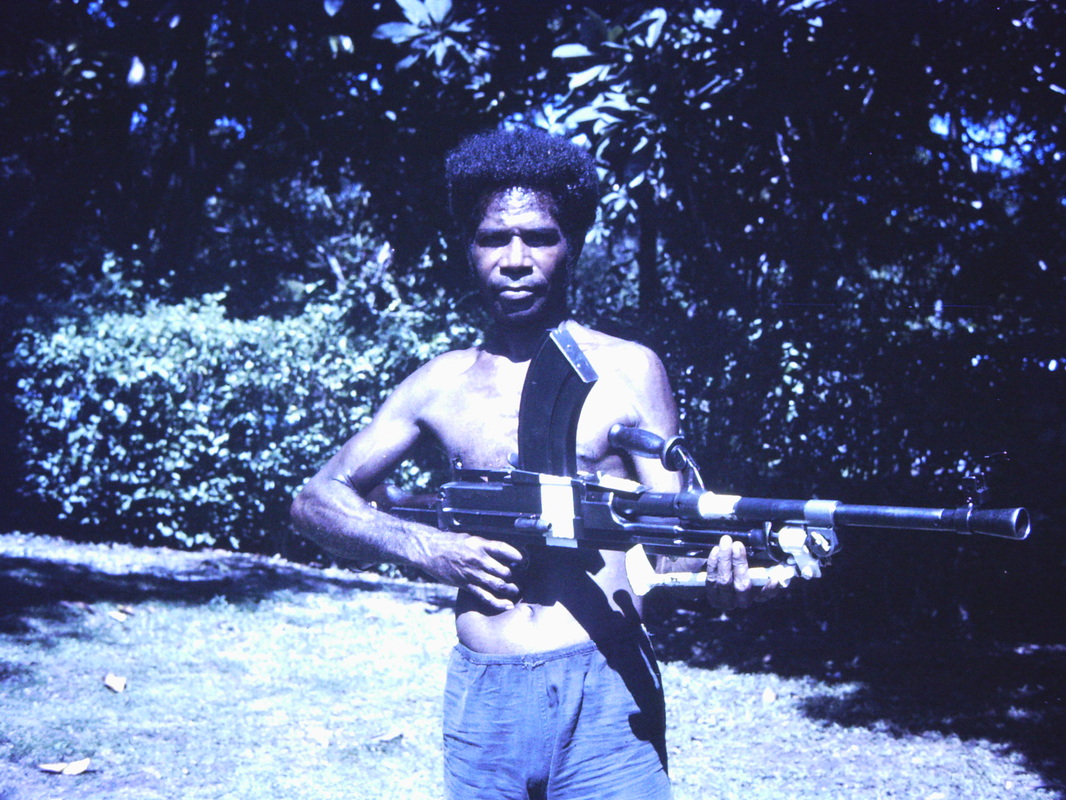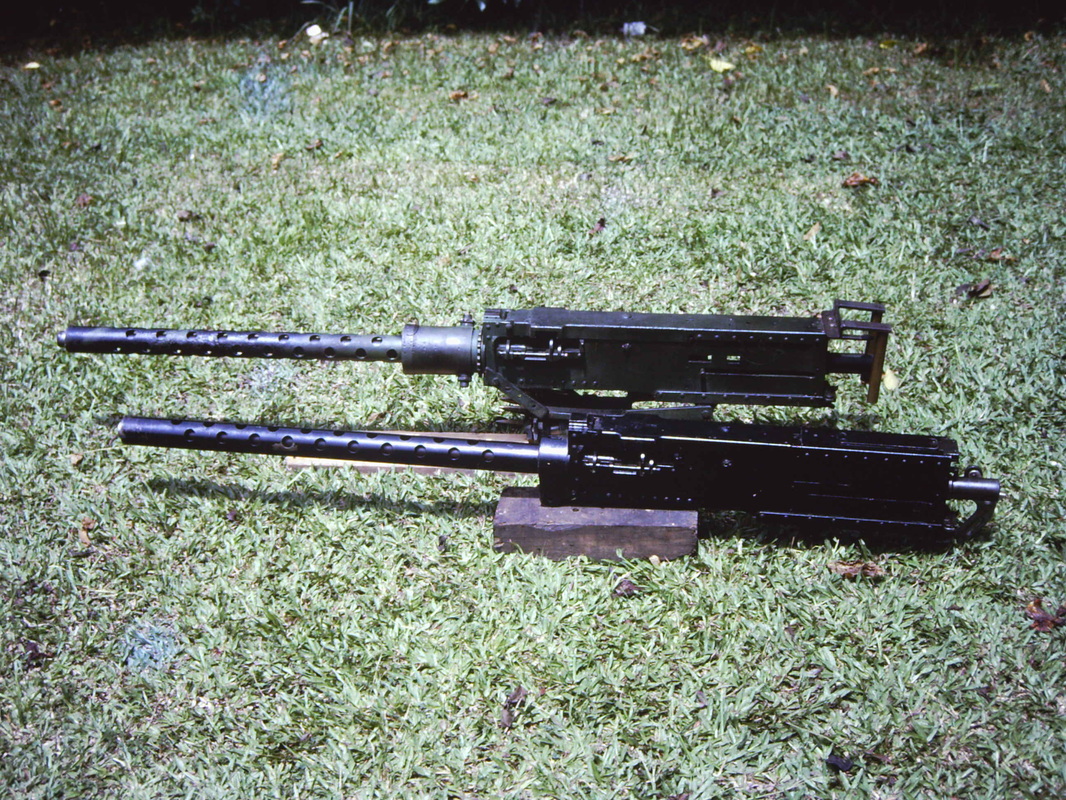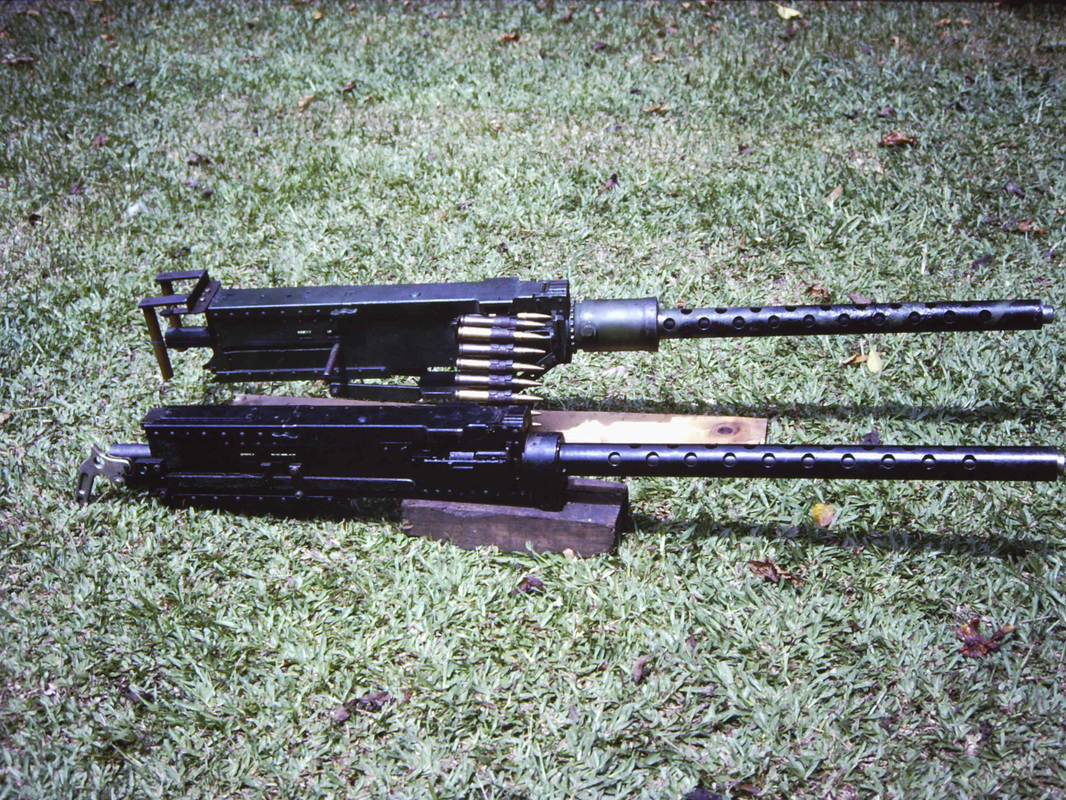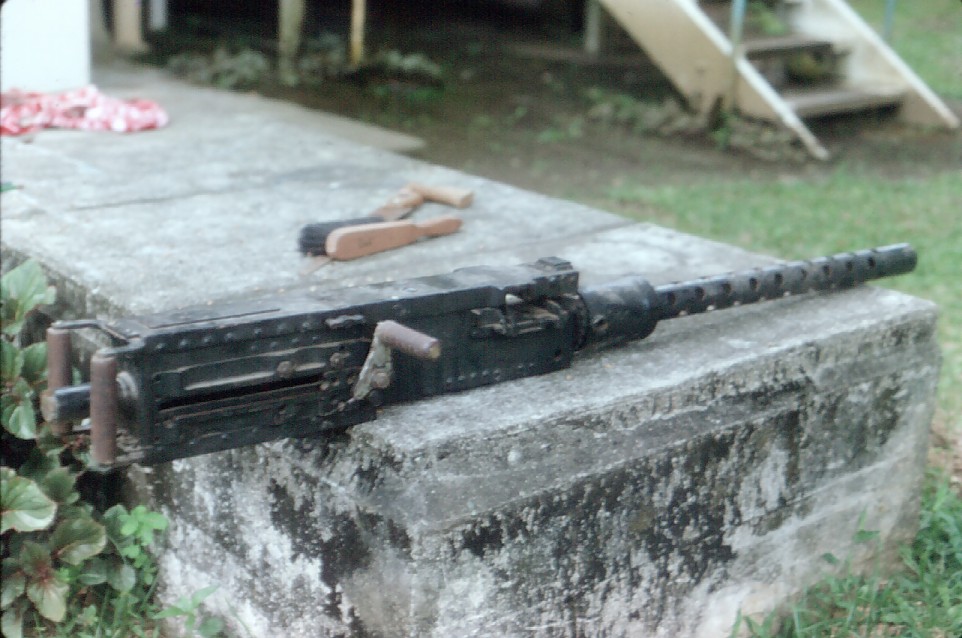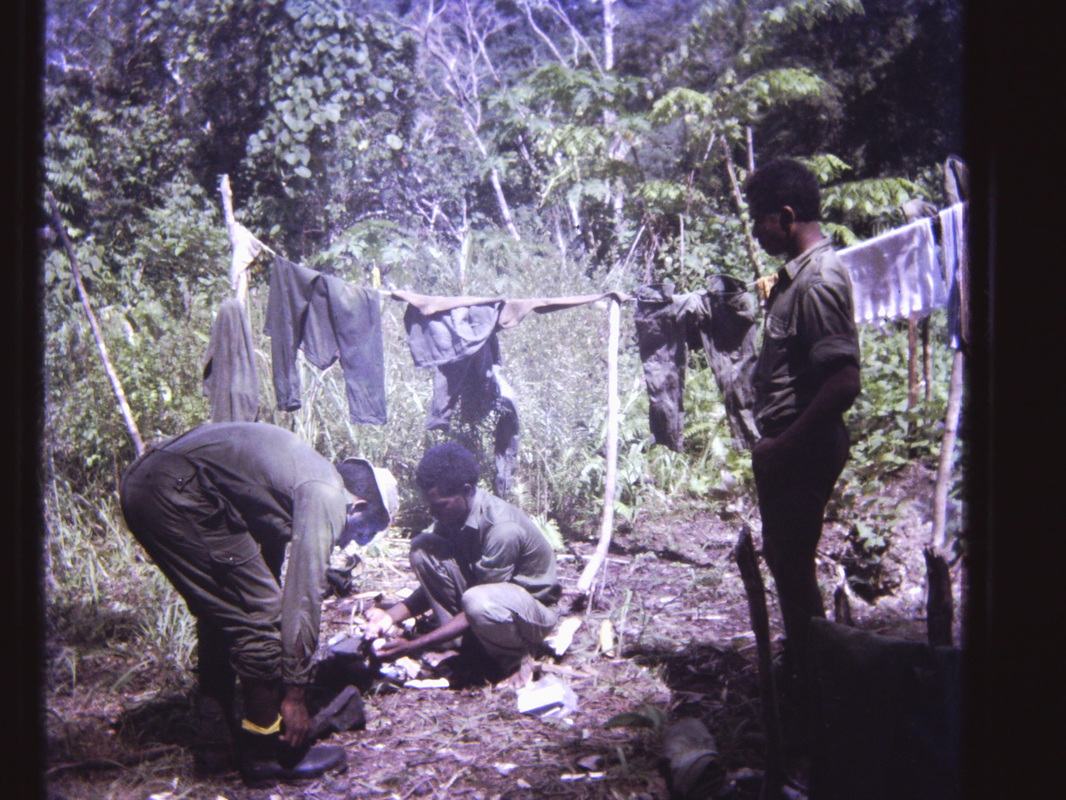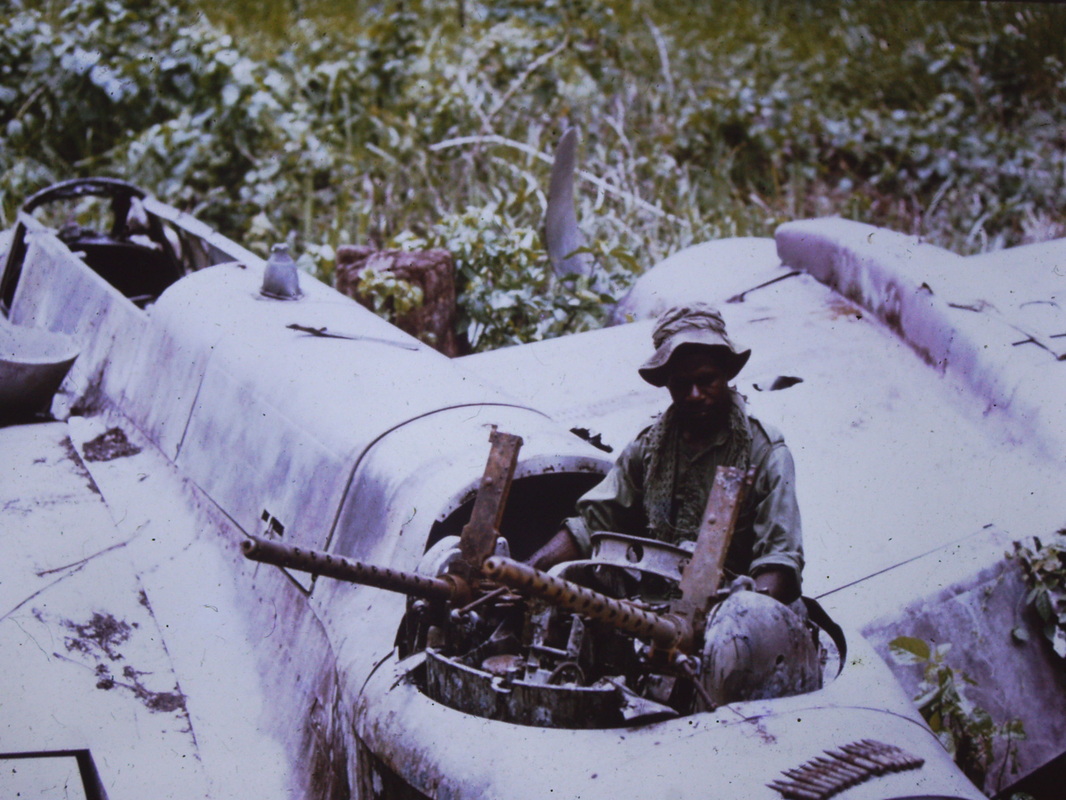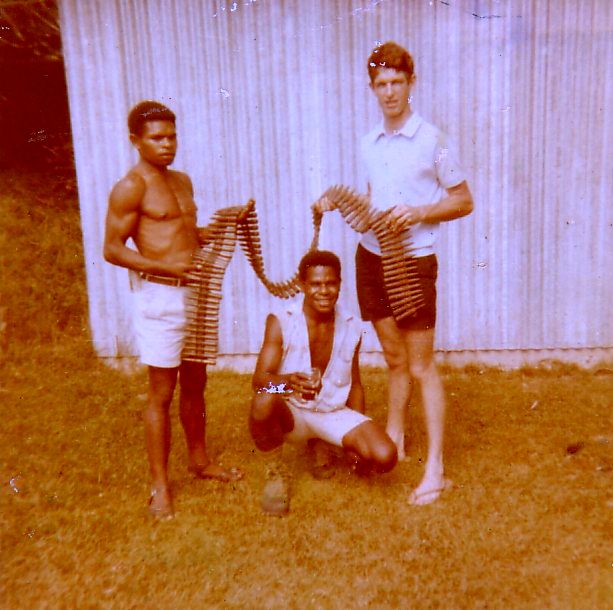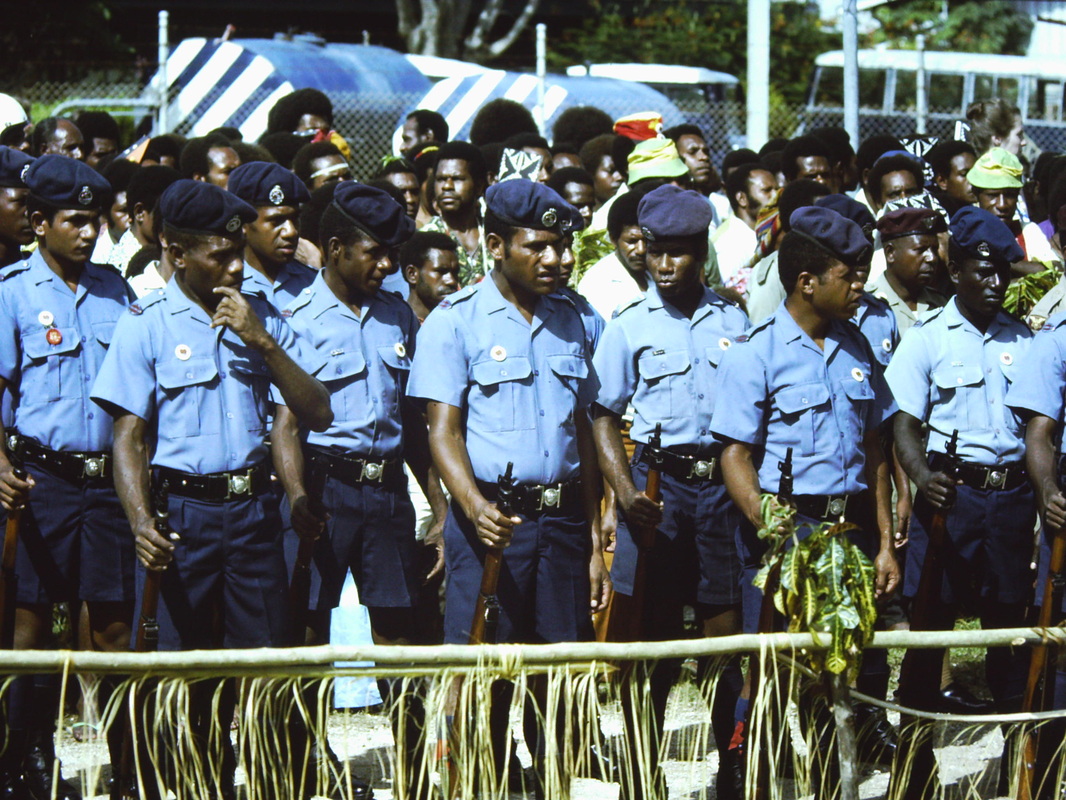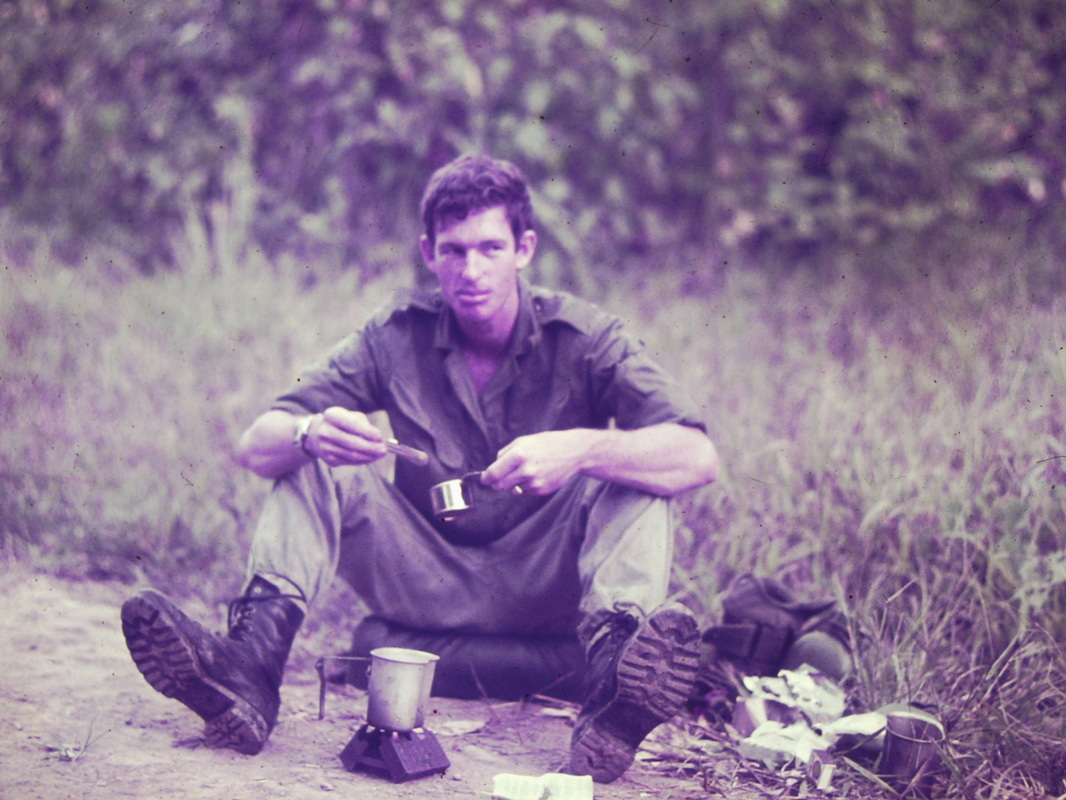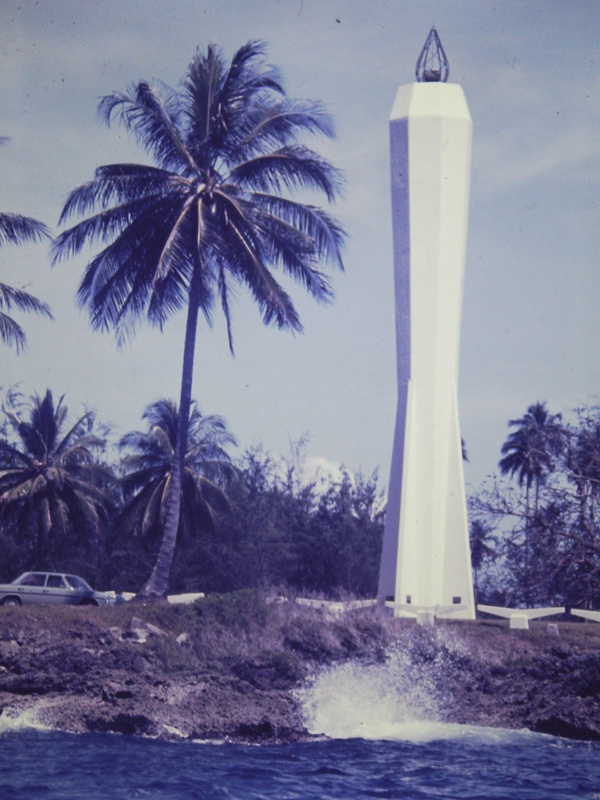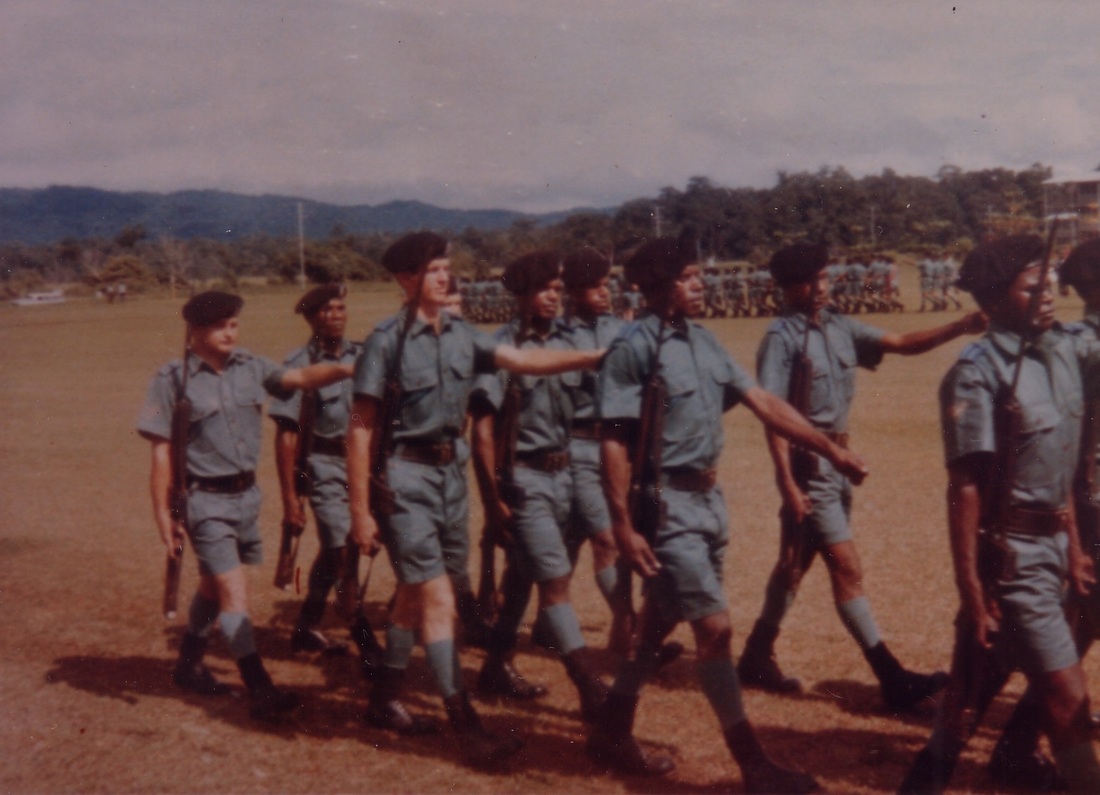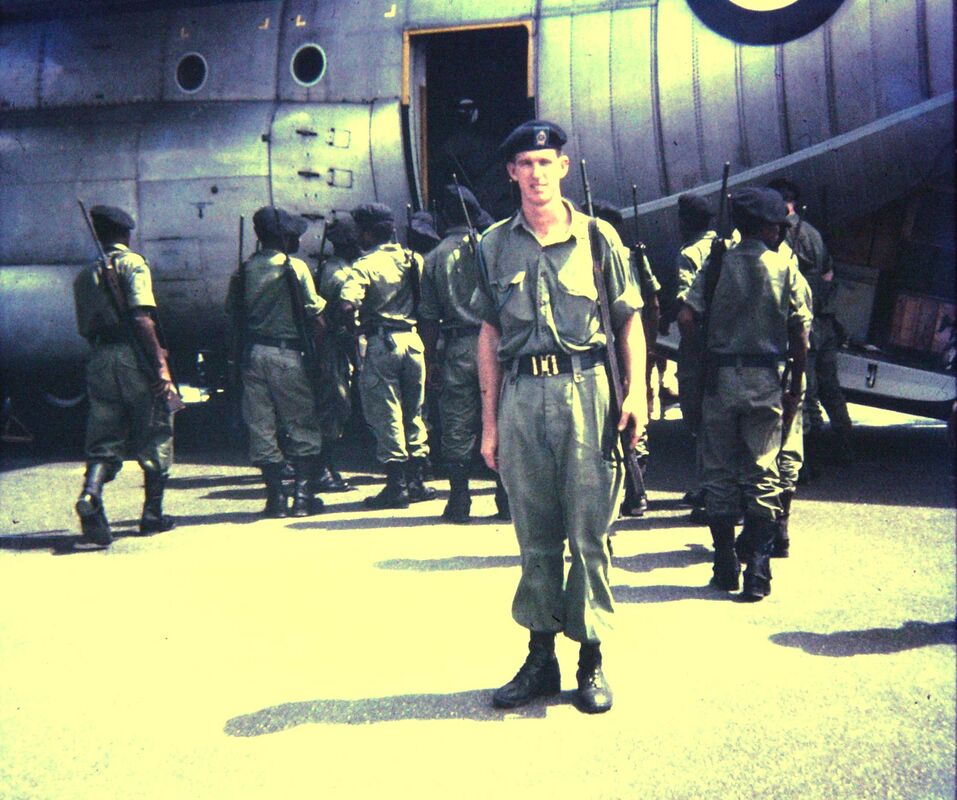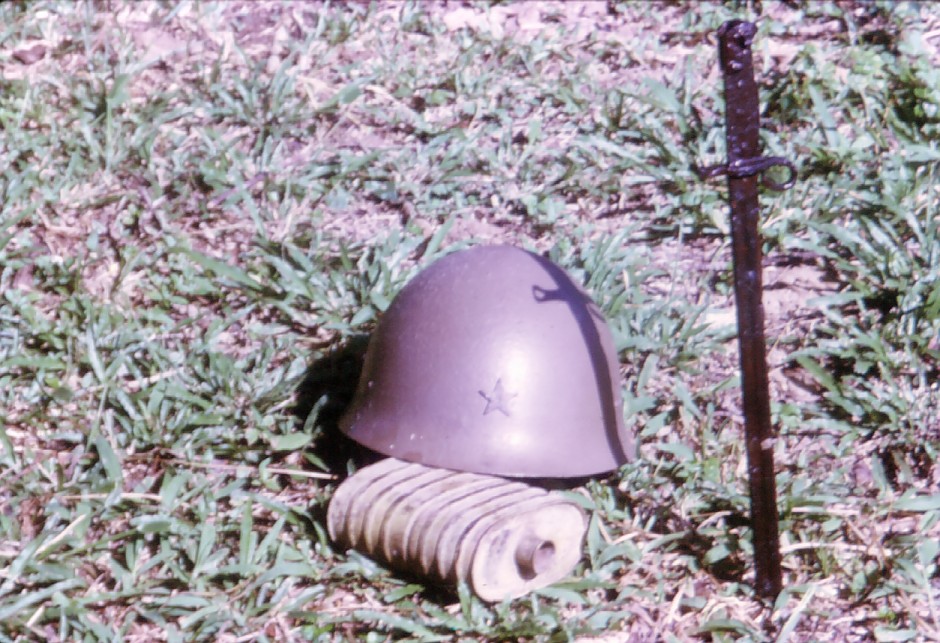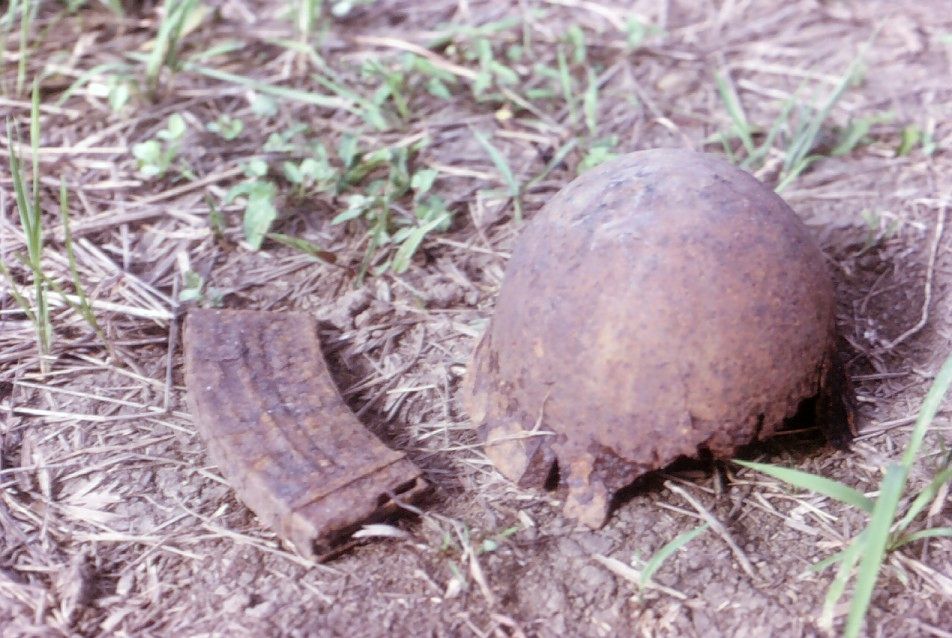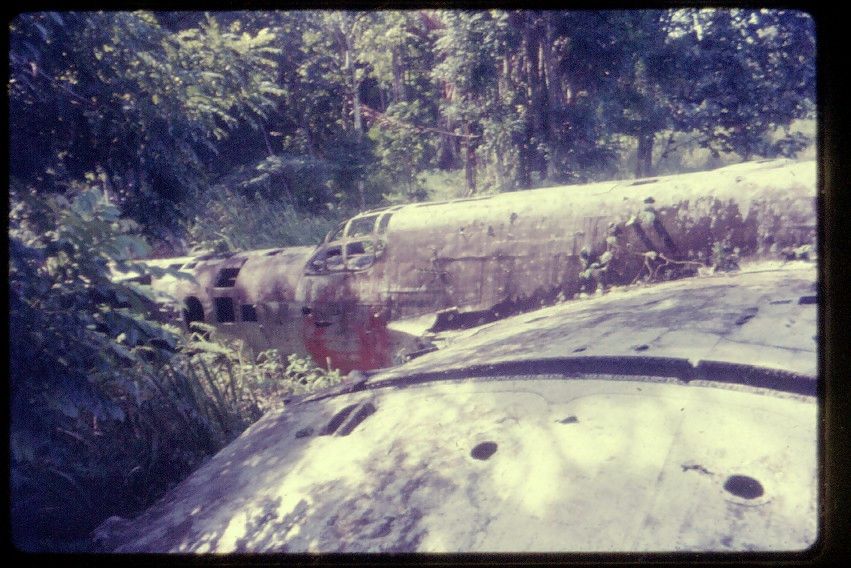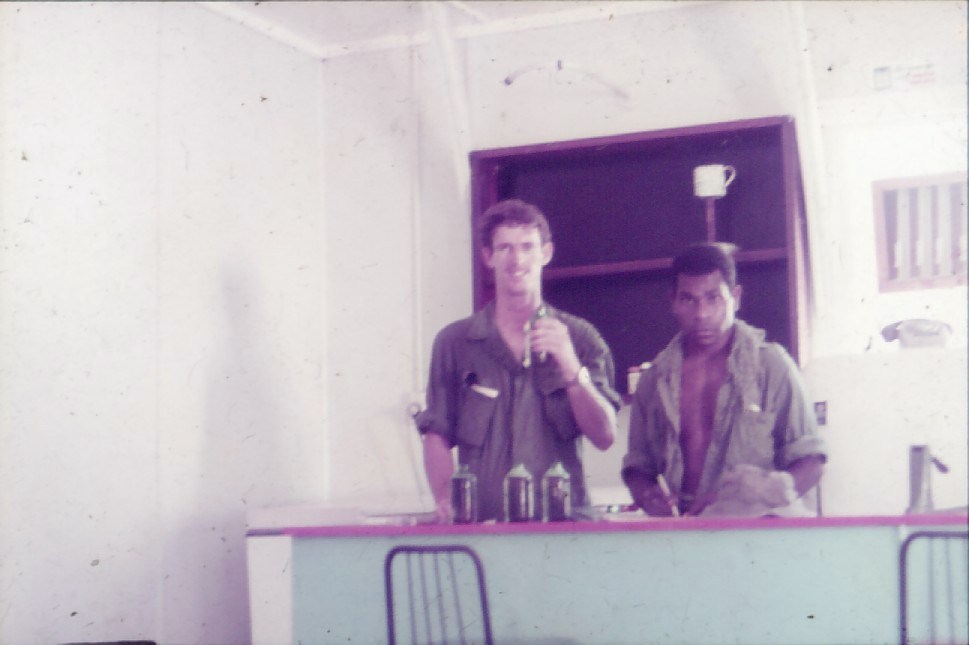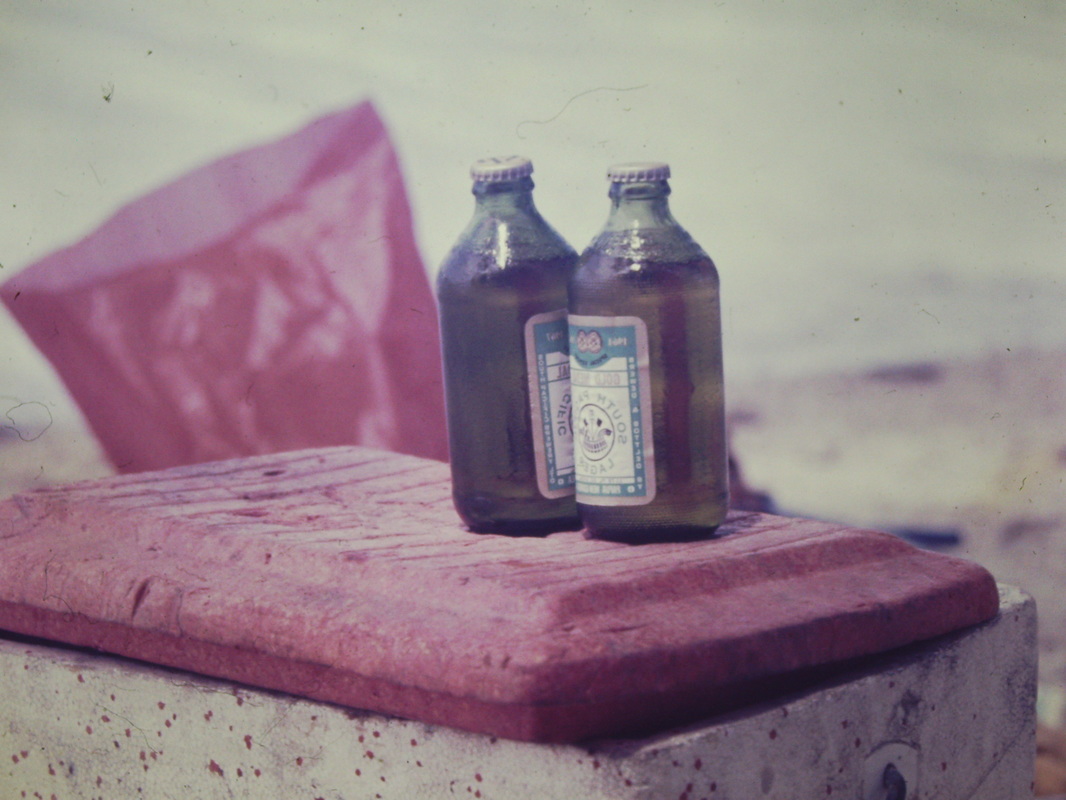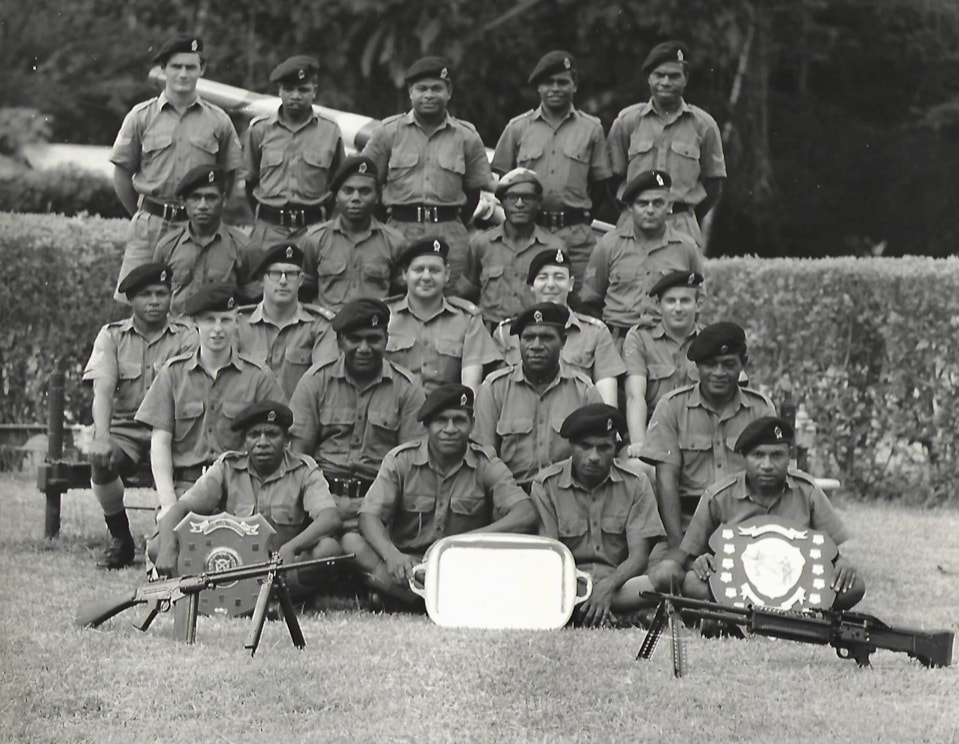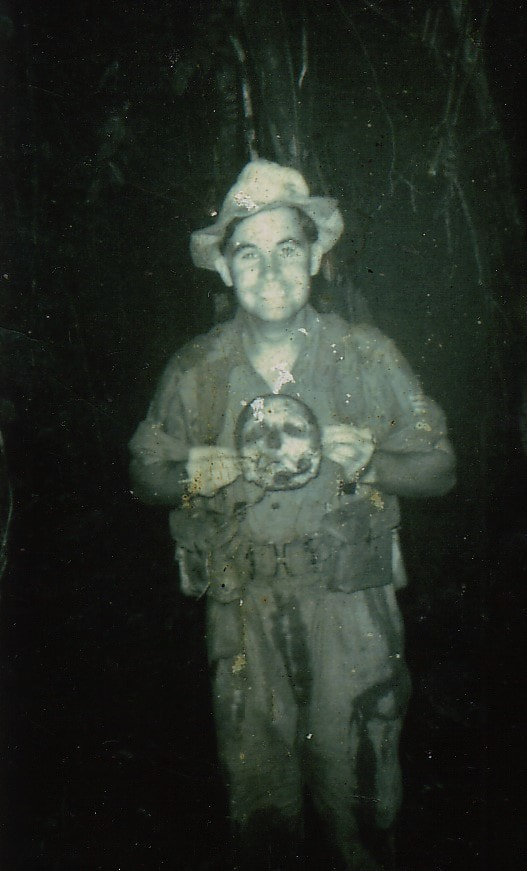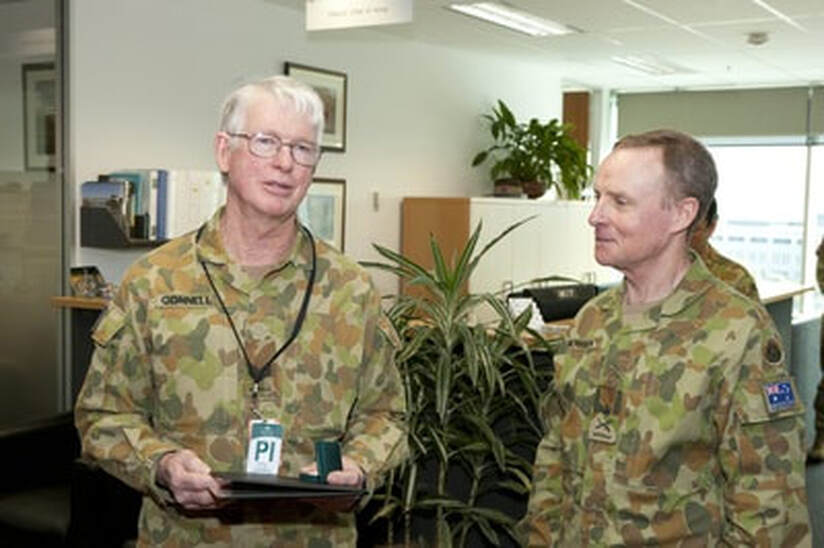12 Pl D Coy Madang
The Madang Platoon of PNGVR commenced in April 1954 when a platoon designated 2 Pl A Coy under Lt Peter Harbeck was formed.
On 1st April, 1960 the Madang Platoon was redesignated 7 Pl C Coy with Lt L.G. (Chicka) Hutson as Pl Comd.
In 1963 the Madang Platoon again became a part of A Coy being designated 3 Pl A Coy with S/Sgt Stan Gould as Pl Comd.
On 4th March, 1966 the Madang Platoon became 12 Pl D Coy with S/Sgt Stan Gould as Pl Comd.
On 1st April, 1960 the Madang Platoon was redesignated 7 Pl C Coy with Lt L.G. (Chicka) Hutson as Pl Comd.
In 1963 the Madang Platoon again became a part of A Coy being designated 3 Pl A Coy with S/Sgt Stan Gould as Pl Comd.
On 4th March, 1966 the Madang Platoon became 12 Pl D Coy with S/Sgt Stan Gould as Pl Comd.
12 Platoon D Company Madang Depot. The Q Store was at this end, then the Admin Office, a small lecture space and at the far end, the canteen. A covered training area was at the far end. The shed on the extreme right held stores.
Bernie Arnold was a member of the Madang Pl. Bernie said:
"SGT Stan Gould, the Pl Comd, was the best organiser I have ever met. With his drive, the Madang Drill Hall and grounds received a prize for neatness. I made a sign with large PNGVR badge, fret-sawed from very heavy waterproof ply and painted and placed at the entrance to the hall (depot) – a 20mm Japanese cannon was mounted on a concrete pad next to the sign. Stan organised all the materials. Later, the unit retrieved a 75mm gun from Alexishafen and set it up on the front boundary." (See the photo below)
(PNGVR: A History - 1950 - 1973, p125 by MAL Bob Harvey-Hall RFD ED)
Bernie Arnold was a member of the Madang Pl. Bernie said:
"SGT Stan Gould, the Pl Comd, was the best organiser I have ever met. With his drive, the Madang Drill Hall and grounds received a prize for neatness. I made a sign with large PNGVR badge, fret-sawed from very heavy waterproof ply and painted and placed at the entrance to the hall (depot) – a 20mm Japanese cannon was mounted on a concrete pad next to the sign. Stan organised all the materials. Later, the unit retrieved a 75mm gun from Alexishafen and set it up on the front boundary." (See the photo below)
(PNGVR: A History - 1950 - 1973, p125 by MAL Bob Harvey-Hall RFD ED)
On parade for ANZAC Day 1971. Note the Police station in the background. SGT Arua Paru calling the roll. It always amazed me how these soldiers could parade in perfectly starched and pressed Junipers.
CPL Duncan Wamatabe (L) and SGT Arua Paru. Stalwarts of 12 PL. Not sure why the CPL was wearing the red sash and not the SGT? Maybe it was his turn! Duncan was later promoted to SGT.
This Japanese anti-aircraft gun was pulled out of the bush near Alexishafen... not a bad effort considering we had no cranes or proper lifting gear. I think that it was about 3 inch calibre. It was placed in the front of the depot. It was removed after PNGVR was disbanded and is now on display in the Canberra war memorial.
(Col Gould.)
(Col Gould.)
Construction of PNGVR Madang Training Camp 1964—66
Photo above.
Rear standing: Sgt Bernard Arnold
Front L-R: WO2 Malea Ealedona, Unknown, Pte Eddie Matthies
All materials were donated and Madang Platoon members voluntarily carried out the work.
The Camp, constructed at Rempe, outside Madang , consisted of:
· Orderly room / Officers Quarters
· OR’s Quarters
· Radio Hut
· Mess Hut
· Haus Cook
· Shower Block
· Flushing toilet
· Parade Ground
· 240 V Generator Hut (5 KVA)
S/Sgt Stan Gould was the moving inspiration behind the project, and was told by COL Mal Bishop that this was the only PNGVR project that didn’t cost the PNGVR any money!
Says Bernie Arnold:
"The crowning project of Stan was the camp at Baitera near Rempi. It ended up with a Quonset hut with a concrete floor with vinyl covering, a flushing toilet and septic tank. Finally, even showers were put in. We shovelled loose concrete into 44 gal drums from Steamies (Steamships Trading Company) for the floors at the huts and built a gravel road into the camp. Much of the work at the camp was done by the ‘calaboose line’ with which Stan had good connections."
(PNGVR: A History - 1950 - 1973, p125 by MAL Bob Harvey-Hall RFD ED)
Photo below. The completed camp.
Photo above.
Rear standing: Sgt Bernard Arnold
Front L-R: WO2 Malea Ealedona, Unknown, Pte Eddie Matthies
All materials were donated and Madang Platoon members voluntarily carried out the work.
The Camp, constructed at Rempe, outside Madang , consisted of:
· Orderly room / Officers Quarters
· OR’s Quarters
· Radio Hut
· Mess Hut
· Haus Cook
· Shower Block
· Flushing toilet
· Parade Ground
· 240 V Generator Hut (5 KVA)
S/Sgt Stan Gould was the moving inspiration behind the project, and was told by COL Mal Bishop that this was the only PNGVR project that didn’t cost the PNGVR any money!
Says Bernie Arnold:
"The crowning project of Stan was the camp at Baitera near Rempi. It ended up with a Quonset hut with a concrete floor with vinyl covering, a flushing toilet and septic tank. Finally, even showers were put in. We shovelled loose concrete into 44 gal drums from Steamies (Steamships Trading Company) for the floors at the huts and built a gravel road into the camp. Much of the work at the camp was done by the ‘calaboose line’ with which Stan had good connections."
(PNGVR: A History - 1950 - 1973, p125 by MAL Bob Harvey-Hall RFD ED)
Photo below. The completed camp.
Rempi Training Camp north of Madang and looking rather sad and neglected!. We went there a couple of times at the most, from 1970 to 1975 otherwise, it was unused.
CPL (later SGT) Trevor Connell, 1970, relaxing in the mess at Steamships Trading Company Shipyard before going to the Tuesday night parade.
What the well dressed SIG wore. SGT Trevor Connell ready for camp - 1972 Note the SMG F1. Today, it would be a breach of safety in that the finger was inside the trigger guard and not outside.
Can't recall why we had a DP Bren gun. (webmaster)
SGT Trevor Connell (webmaster)
Even the gardener wanted his photo taken ! (Yes, 12 Pl had a gardener... I don't know who paid him.)
The two .50 cal HMGs that lived in the armoury. It didn't appear strange or unusual to have these together with an OMC (Owen) Gun and Japanese Arisaki rifle in the armoury...! Regimental property? On a visit by the CO one day, he instructed us to "get rid of them". They were taken next door to the police station where we got a receipt for them. I wonder what they did with them...
Extract from "Memories of the PNGVR" by Bernard Arnold in HTT Aug 12
“Another exercise was to walk from Utu to beyond Amaimon in the Gogol valley to visit the crash-landed American Boston fighter-bomber. We stayed the night at Amaimon and walked back to Utu the next day. Two .50 cal Browning machine guns were taken out of the aircraft and brought to Madang where one Platoon member, Ian Grattidge who worked for DCA, restored them to working order. Both guns had a round in the chamber and to ‘extract’ them, he fired a .22 rifle at the round from a safe distance.”
Extract from "Memories of the PNGVR" by Bernard Arnold in HTT Aug 12
“Another exercise was to walk from Utu to beyond Amaimon in the Gogol valley to visit the crash-landed American Boston fighter-bomber. We stayed the night at Amaimon and walked back to Utu the next day. Two .50 cal Browning machine guns were taken out of the aircraft and brought to Madang where one Platoon member, Ian Grattidge who worked for DCA, restored them to working order. Both guns had a round in the chamber and to ‘extract’ them, he fired a .22 rifle at the round from a safe distance.”
These guns were salvaged from a crashed aircraft (by Ian Grattidge) They differ from a vehicle mounted gun in that they have the air cooling over the barrel and no trigger (the far one had been modified by someone in 12 Platoon! It actually worked!). They were fired electrically with a solenoid. Legend has it that when they were tested in someone's garage, they shot the back wall out...! Quite possible.... Incidentally, those rounds in the photo were 'live'.!
Refurbishment of one of the .50 cals. Handles were made and the cocking handle fitted. This was necessary as they were out of an aircraft.
A bivouac near Madang circa 1972. An apparently relaxed event...
PTE Rafael Kasar in a crashed BOSTON aircraft just north of Madang. This is the crashed aircraft that the above 50 cals were obtained.
The ammo for the .50 cals was kept in the garden shed at the back of the depot! It was eventually taken and dumped in a creek on the way to Rempi on the orders of the CO.(L-R) PTE ? (a SEPIK I think), PTE Rafael Kasar, SGT Trevor Connell
Ok... it's not PNGVR but this was the Police contingent at Independence Day. Note the Independence badge and the No 4 SMLE .303's. We used SLR's, they only had .303's .... but it sounded impressive to the locals when they worked the bolt to cock the rifle! ... much better than an SLR. The legend was that SUPT Mike Thomas, when he was in charge of Pt Moresby and there was trouble at the lower pub, he would take his police squad in, order them to load and ..... there would be instant silence and order!!!
Note the excellent training - there is not a single hand over the end of the barrel...
Note the excellent training - there is not a single hand over the end of the barrel...
SGT Trevor Connell having breakfast on a bivouac (note the small tin of ham and eggs!) I am sitting on the cushion out of the Land Rover. Ignore the grumpy look! ... it is probably because someone just said "Packs on, Move out!" Also note the 2 cups, canteen, steel. A very switched on digger! I had my own GP boots as the system didn't provide them then. I loved them.
Anyone who has been to Madang will recognise the Coastwatcher's Memorial at the entrance to the harbour.
12 Platoon, D Company on a parade at Igam Barracks. SGT Trevor Webb (L) with SGT Trevor Connell in front of him.
SGT Trevor Connell with 12 Platoon boarding a C130 in Madang to go to Lae for the annual camp.
"We drove the land rover out onto the tarmac to load onto the aircraft without getting permission from the tower. They were quite upset.... we apologised of course !!!"
"We drove the land rover out onto the tarmac to load onto the aircraft without getting permission from the tower. They were quite upset.... we apologised of course !!!"
Japanese helmet, gas mask filter and bayonet salvaged near Madang by Trevor Connell.
A Japanese 'Betty' bomber at the Alexishafen (Sek) airfield. Note the red markings still visible on the fuselage.
SGT Trevor Connell and PTE Rafael Kasar in the Canteen. Note the Nobanob Cup in the shelf. The Nobanob cup has a story....
The Madang Nobonob Cup – A Background.
By Bernie Arnold
I was first posted to Madang late in 1960 as a District Accounts Clerk. On arrival I noticed that the few roads around Madang were generally on the level coastal strip, so I bought myself a bicycle to give me some mobility. This bicycle got me some 50K up the North Coast Road and some 25K south into the hills to Amele Village. There were no frills such as lights, but I did add a battery-operated horn to clear my path as the brake was not very effective on steep descents. Sometimes I created moments of panic in unsuspecting pedestrians, who chatted loudly and thinking themselves remote from any motor vehicle, were suddenly about to be run down from behind.
I had joined PNGVR in Port Moresby earlier that year and Madang had a small but very active contingent, both in military training and social activities, such as picnics, golf days etc.
After the business part of the Platoon’s weekly training parade, members would adjourn to the adjacent small Mess for social drinks, card games and general conversation. One evening Percy Neville and I got talking about bicycles. Several others joined in and called “Challenge!” and a race was on.
Most of the 19K to Nobonob Hill was level but the last 2K went up a very steep track to the Mission. The weather on the Sunday of the ‘challenge race’ was the usual sunny, super steamy 30 degrees C. ‘Chica’ Hutson, our OC, flagged us off. Once on the Nobonob track I walked the bike to the summit where a control point was located and walked the bike most of the way down again and met Percy walking his ‘wiliwil’ up.
Percy claimed he had been unable to get fit for this run and demanded a rematch. This occurred about 2 months later and this time I made the round trip in two hours but Percy had collapsed on top of Nobonob but recovered.
From time to time the cup would be taken down from its place of honour above the bar and a toast would be drunk by all.
The Cup was an old enamel mug, mounted on a piece of wood on a surplus aluminium saucepan lid as a base. As it leaked it was never able to hold champagne but turned upside down the base saucepan lid could hold biscuits which could be handed around and a ‘toast’ eaten instead.
Footnote by Colin Gould.
Later in the 60’s and 70’s the ‘Cup’ although leaking, held one full SP stubbie, and was used to celebrate promotions, marriages etc… the celebrant having to skoll the entire contents.
Footnote By Trevor Connell
In the 70's, we never used it - it looked too disgusting !!!
Who can forget the SP greenie!
12 Pl D Coy PNGVR Madang, circa 1968.
Back: Bob Carmichael, Duncan Wamatabe (also see photo 3),Elias Sakbua, Steven ?, ?
2nd Back. ?, ?, Mathew Ber, Eddie Matthies
Middle. Sgt Malea Ealadona, Lt Jes Hansford, Maj Neville Harris, Lt Daryll Smith, Colin Gould,
2nd Front. David Murray, ?, ?, CPL Arua Paru,
Front. Gregory Aioaio, ?, ?, ?.
There is an L2A2 Automatic Rifle on the left and an M60 GPMG on the right.
Photo Daryll Smith.
David Murray worked at the Commonwealth Bank in Madang as a teller and subsequently went on to become CEO of the Commonwealth Bank, Chair of the Federal Governments Future Fund, and was recently appointed Chairman of AMP following the Financial Services Royal Commission.
WO2 Brian Smith: He was the ARA Cadre. He used to come down to Madang from Wewak where he lived. The visit was supposedly to check the correct operation of this remote locality and undoubtedly he did. Otherwise, he'd 'borrow' the unit land rover for transport and have a relaxed time. I think he stayed at Smugglers Inn or maybe the Madang hotel. Brian and I would go to the Madang Club for a drink every day.
Back: Bob Carmichael, Duncan Wamatabe (also see photo 3),Elias Sakbua, Steven ?, ?
2nd Back. ?, ?, Mathew Ber, Eddie Matthies
Middle. Sgt Malea Ealadona, Lt Jes Hansford, Maj Neville Harris, Lt Daryll Smith, Colin Gould,
2nd Front. David Murray, ?, ?, CPL Arua Paru,
Front. Gregory Aioaio, ?, ?, ?.
There is an L2A2 Automatic Rifle on the left and an M60 GPMG on the right.
Photo Daryll Smith.
David Murray worked at the Commonwealth Bank in Madang as a teller and subsequently went on to become CEO of the Commonwealth Bank, Chair of the Federal Governments Future Fund, and was recently appointed Chairman of AMP following the Financial Services Royal Commission.
WO2 Brian Smith: He was the ARA Cadre. He used to come down to Madang from Wewak where he lived. The visit was supposedly to check the correct operation of this remote locality and undoubtedly he did. Otherwise, he'd 'borrow' the unit land rover for transport and have a relaxed time. I think he stayed at Smugglers Inn or maybe the Madang hotel. Brian and I would go to the Madang Club for a drink every day.
The above photo was found in the cupboard when 12 Pl was disbanded. Does anyone know who it is? It must have been late 60's as he is wearing 56 pattern webbing. It must also have been a bivouac as anti-mite repellant can be seen around every opening and seam …. a conscientious digger! Shame about the person he is holding.
2015. (Still a ..) SGT Trevor Connell receiving his Federation Star for 40 years service from the Chief of Army. The Federation Star was introduced.as the service ribbon had insufficient space for 5 rosettes. Trevor was "retired" a couple of years later.
